- Publisher's Note
- Editorial
- Guerrilla Girls: The Masked Culture Jammers of the Art World
- Creating for Change: Creative Transformations in Willie Bester’s Art
- Radioactivists -The Mass Protest Through the Lens
- Broot Force
- Reza Aramesh: Action X, Denouncing!
- Revisiting Art Against Terrorism
- Outlining the Language of Dissent
- In the Summer of 1947
- Mapping the Conscience...
- 40s and Now: The Legacy of Protest in the Art of Bengal
- Two Poems
- The 'Best' Beast
- May 1968
- Transgressive Art as a Form of Protest
- Protest Art in China
- Provoke and Provoked: Ai Weiwei
- Personalities and Protest Art
- Occupy, Decolonize, Liberate, Unoccupy: Day 187
- Art Cries Out: The Website and Implications of Protest Art Across the World
- Reflections in the Magic Mirror: Andy Warhol and the American Dream
- Helmut Herzfeld: Photomontage Speaking the Language of Protests!
- When Protest Erupts into Imagery
- Ramkinkar Baij: An Indian Modernist from Bengal Revisited
- Searching and Finding Newer Frontiers
- Violence-Double Spread: From Private to the Public to the 'Life Systems'
- The Virasat-e-Khalsa: An Experiential Space
- Emile Gallé and Art Nouveau Glass
- Lekha Poddar: The Lady of the Arts
- CrossOver: Indo-Bangladesh Artists' Residency & Exhibition
- Interpreting Tagore
- Fu Baoshi Retrospective at The Metropolitan Museum of Art
- Random Strokes
- Sense and Sensibility
- Dragons Versus Snow Leopards
- What Happened and What's Forthcoming
- Art Events Kolkata, February – March 2012
- Mumbai Art Sighting
- Art Bengaluru
- Delhi Dias
- Musings from Chennai
- Preview, March, 2012 – April, 2012
- In the News, March 2012
- Cover
ART news & views
Reflections in the Magic Mirror: Andy Warhol and the American Dream
Issue No: 27 Month: 4 Year: 2012
by Sritama Halder
 Andy Warhol’s works took a critical look at the way of life that thrived on a new culture of capitalism and consumerism that emerged after the World War II. His art borrowed images from the existing popular visual culture and mass media such as advertisements, comics, films etc and thus came to known as Pop (derived from popular) art. Denying the grand and the metaphysical, Pop art embraced the everyday and the mundane. Founded on specific economic and political conditions pop art, a form of social realism indifferently deified the consumerist culture that came to define the Great American Dream and in the process condemned its promotion of unbridled greed for a life bettered by materialistic bliss.
Andy Warhol’s works took a critical look at the way of life that thrived on a new culture of capitalism and consumerism that emerged after the World War II. His art borrowed images from the existing popular visual culture and mass media such as advertisements, comics, films etc and thus came to known as Pop (derived from popular) art. Denying the grand and the metaphysical, Pop art embraced the everyday and the mundane. Founded on specific economic and political conditions pop art, a form of social realism indifferently deified the consumerist culture that came to define the Great American Dream and in the process condemned its promotion of unbridled greed for a life bettered by materialistic bliss.
These specific economic and political situations were created by two of the decisive factors in the American economy of the 20th century namely the Great Depression in the 30s and the World War II (1939-1945). The Depression originated In the USA in September, 1929 when the stock prices began to fall. On 29th October the stock market crashed. The Depression rapidly spread all over the world. It led to enormous increase in the unemployment rate, poverty and the resultant increase of crime level and the number of suicides.
For America the World War II was remedial to this massive economic crisis by revitalizing the American economy. It effectively ended the Depression in the USA. The federal government of America came out of the war as a powerful economic agency as it was able to regulate and partially control the country’s economy by spending and consumption.
In the beginning of the war, as a neutral country, America was selling materials like petroleum, tools, machinery etc to both sides till it joined the war after the bombing on Pearl Harbor. Most of the industries and factories such as car manufacturing companies were forced to produce more of war machineries than civilian goods and they were all directly or indirectly attached to either manufacturing or aiding the war necessities and defense supplies (such as tanks, aeroplanes, weapons, atomic energy etc).
World War II provided an answer to the question of unemployment in America caused by the Depression. The war caused a shortage of employees who joined the war but by mobilizing the unemployed including women and children the national income increased manifold. As, by 1943, almost half of the American products went overseas, personal and the family income increased substantially. The accumulated money led the American people to dream of a better and improved post-war life. By the end of the war its global scale damaged the economical structure of every country that was even remotely involved in it except America and thus the nation emerged as the strongest economic and political power in the post World War era.
The seeds of a consumerist culture aided by the ever increasing personal and national capital that were sown during the time of the war borne fruit over the following years and gathered momentum in the 60s. For example, the number of shopping malls in America increased from below ten at the end of the war to almost 4000 by the 60s.


In this condition Pop art emerged as early as in the mid 1950s. Jasper Johns’ images of targets and the American flag are considered as the precursors of Pop art. Johns painted and manually multiplied the American flag by painting the image on a flat surface of the canvas. In this series Johns subjected the flag to various permutations. He drained of its normal colour palette, treated the flag as a part of landscape. He painted the flags treating them as small portrait photos, increased and decreased the flag’s size and casted them in bronze. This way the flag – a sign of nationhood and its claims of power over the citizens with a sense of ownership was reconfigured as a different object, alienated from its political and ideological context.
However, more than his paintings, Johns’ sculptures had more influence on the development of Pop art. Two sculptures Painted Bronze (both in 1960) embodied most of the traits of Pop art. In these works Johns replicated the Ballentine Ale cans in bronze and hand painted the labels on them. With these sculptures Johns further moved towards what only a few years after would be known as Pop art.
With Jasper Johns paving the way for Pop art with his flags and cans and Andy Warhol, its principal practitioner previously working as a commercial artist doing sign paintings, store decoration and illustrations a whole archive of images from the mass culture was ushered into the realm of high art.
Warhol began his journey as an artist in the 60s which was a time marked by a complicated web of cultural and political movements not only in America but across the world. In America this decade was marked by counterculture, subversion, anti-war and anti-institutional movements and social revolutions. It was a decade of happy irresponsibility and flamboyance. Sexist and gender related taboos began to relax making way for open access to sex and drugs.
Working during this period Warhol introduced counterculture and subversion in the realm of high art by introducing clippings from news papers, images from billboards, postcards and posters. Through his paintings and later silk screen prints, he represented America as a nation that was built solely upon consumerism and transaction. In one of his works he wrote, “I adore America and these are some comments on it. My image is a statement of the symbols of the harsh, impersonal products and brash materialistic objects on which America is built today. It is a projection of everything that can be bought and sold, the practical but impermanent symbols that sustain us”.
Warhol worked with objects which were ordinary and remained forever unnoticed yet intrinsically embedded into a nation’s cultural identity. The most significant of his works from this period are on Coca-Cola, Campbell’s Soup cans and the portraits of Marilyn Monroe. The formula of Coca-Cola was invented in the late 19th century and promoted as a patent medicine believed to be able to cure dyspepsia, headache and even impotence. By 1936, at the time of Coca-Cola’s 50th anniversary the drink had been given the status of a national icon and the symbol of the American success.
Though the Coca-Cola Company holds the exclusive right over its formula it allows independent bottlers to add sweetener to bring in the local flavours. It also makes small changes to its name to fit into a different cultural condition (for example Cola Turka, Zam Zam Cola, Mecca Cola etc). It has spent billions of dollars for advertisements and propagandas in order to become what it is today – namely a life style or an aspiration of a life style. Through Coca-Cola “the values of the United States are propagated around the world”. Thus the drink also functions as the symbol of the nation’s cultural imperialism which is the condition that allows one nation to dominate and mould another nation’s cultural values. A major aspect of the process of the cultural imperialism is to export its cultural products into another nation.
That Coca-Cola symbolized the common man’s aspiration for a better life especially appealed to Warhol. He pointed out, “What’s great about this country is that America started the tradition where the richest consumers buy essentially the same thing as the poorest. You can be watching TV and see Coca-Cola, and you can know that the President drinks Coke, Liz Taylor drinks Coke, and just think, you can drink Coke, too. A Coke is a Coke and no amount of money can get you a better Coke.”
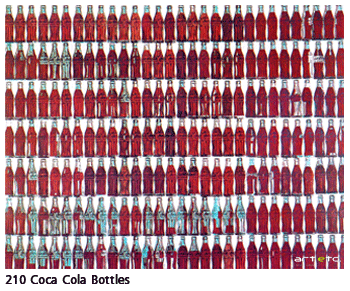 In 1962 he painted another work titled 210 Coca-Cola Bottles. In this work he repeated the image of three Coke bottles arranged in a row to multiply them to 210 bottles. His method of deliberately repeating the same image in a single work served two purposes: it stripped the motif off its emotional value and by repeating it over and over again its iconic power was engraved into the audience’s mind.
In 1962 he painted another work titled 210 Coca-Cola Bottles. In this work he repeated the image of three Coke bottles arranged in a row to multiply them to 210 bottles. His method of deliberately repeating the same image in a single work served two purposes: it stripped the motif off its emotional value and by repeating it over and over again its iconic power was engraved into the audience’s mind.
At the first glace all of the 210 bottles look similar but upon a close scrutiny one notices that each bottle is subtly varied in colouring and other deliberate disruptions were also added to them. The formation of the bottles appears to the viewer like display windows of a shop where carefully arranged products lure the passers-by to consume/desire them. Because of the artist’s use of silk screen technique these bottles had the potential to be multiplied in greater numbers, put in different arrangements and other small variations could be added. Coca-Cola, like other consumerist products, comes in a number of different flavours, colours and type. The need and the purpose of using them are created artificially. The multitude of Warhol’s Coke bottles on the rack titillates the desire of buying and consuming in the viewer’s psyche.
Campbell’s Soup Company did the same thing to the American ego. The company, though in a lesser scale than the brand Coca-Cola, again became synonymous to America’s process of cultural colonization. It began in 1860 as a small canning factory in New Jersey and by 1904 it started selling approximately 16 million cans of soup a year.
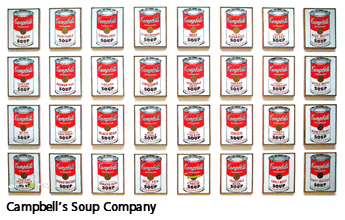 Strategically Campbell’s Soup Company was different from that of Coke. Unlike Coke which propagated an aggressive imperialistic attitude the soup company, by including figures of children in its advertisements, it promoted the happy American family and its values. This nationalist policy had its own advantage. The Cambell’s Kids, in later years, were shown to be taking up personas of policemen, sailors, soldiers and other professions representing the future builders of the nation. An ideal nation requires ideal citizens that can be produced only from within the ideal family units. Campbell’s soup catered to this ideal American family or alternatively the ideal American family endorsed this company’s soup. So again the question of aspiration arose. Families belonging to the country which is a target market for the company aspired to be like the great American family by consuming what it promoted.
Strategically Campbell’s Soup Company was different from that of Coke. Unlike Coke which propagated an aggressive imperialistic attitude the soup company, by including figures of children in its advertisements, it promoted the happy American family and its values. This nationalist policy had its own advantage. The Cambell’s Kids, in later years, were shown to be taking up personas of policemen, sailors, soldiers and other professions representing the future builders of the nation. An ideal nation requires ideal citizens that can be produced only from within the ideal family units. Campbell’s soup catered to this ideal American family or alternatively the ideal American family endorsed this company’s soup. So again the question of aspiration arose. Families belonging to the country which is a target market for the company aspired to be like the great American family by consuming what it promoted.
Warhol made a series of 32 small canvases of identical size depicting all the flavours of the Campbell’s soup available during this time. The consumers (in this case the viewers) are given a number of options to choose from according to his/her taste, inclination, addiction or necessity. The first time this series was exhibited the bottom of each canvas was resting on a rack just like a product would be displayed in a shop. Also Warhol apparently did not have any order according to which these canvases would be arranged. For example, in the Museum of Modern Art (where the canvases are now) they are displayed in chronological order in which the soups were introduced. This way every time they were displayed a new order would be followed. The canvases which are almost indistinguishable would thus rotate like the products that are to be sold and to buy the desired product the buyer would actively take part in finding them.
This series was done with hand-cut stencils and then hand painted. In the later part of 1962 he started using the mechanical process of the silk screen technique. With these two techniques Warhol denied the traditional idea regarding the uniqueness and the expressive potential of painting. By mass-producing his works with the help of a semi-mechanical process and completely eliminating his artistic agency he identified his products with the denial of the individual’s personality and identity which was essentially a modern and American phenomenon triggered off by consumerism. Incidentally he named his studio as Factory because of his assembly-line methods of production and at the same time possibly alluding to the economic structure of America based on industrialism and the mass-production of consumerist goods.
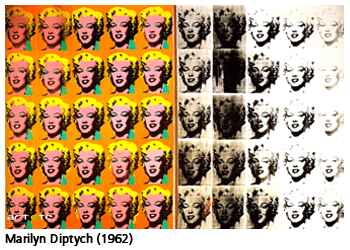 The artist’s most famous silk screen prints works are the ones on Marilyn Monroe. Born as Norma Jean Baker, Marilyn Monroe’s life story is the classic example of rags to riches, her struggle, disturbed childhood, her eventual ascending to fame, multiple husbands and lovers, a reckless life all constituted the kind of story that always appeals to the general public. Thus the story of her life was highlighted by the media. Monroe herself, in her search for fame, lived under the incessant spotlight of public glare and in the process her private self was lost, the person called Norma Jean Baker was forgotten forever into oblivion. What remained was an icon, an illusory object of dream and fantasy that the Hollywood’s myth machine and the media generated.
The artist’s most famous silk screen prints works are the ones on Marilyn Monroe. Born as Norma Jean Baker, Marilyn Monroe’s life story is the classic example of rags to riches, her struggle, disturbed childhood, her eventual ascending to fame, multiple husbands and lovers, a reckless life all constituted the kind of story that always appeals to the general public. Thus the story of her life was highlighted by the media. Monroe herself, in her search for fame, lived under the incessant spotlight of public glare and in the process her private self was lost, the person called Norma Jean Baker was forgotten forever into oblivion. What remained was an icon, an illusory object of dream and fantasy that the Hollywood’s myth machine and the media generated.
In his Marilyn series Warhol looked at the actress as the face of a vacant society. In all the works from this series he used a single photograph. In the Marilyn Diptych (1962) he multiplied this photograph 50 times. The left half of the diptych contains the portrait/s of Monroe executed in garish colours. Her blonde hair is bright golden yellow; the unnaturally red lips are framed by a burnt pink, the drooping eyelids she wears turquoise eye shadow and behind her neck a strip of turquoise green contrasts with the golden orange of the background. From left to right the contrast heightens and the shadow deepens.
The right part shows the same photo but in black and white. Not only this part is different in colour scheme but it is also marked by a deliberately exaggerated use of flawed registration. In this half, the actress’s face is almost indecipherable. Apparently these two parts together chronicle the life and death of Monroe. She lived a colourful and extrovert life, always confronting the public with an artificial smile pasted on her lips. After death, little by little, she must fade away from the public memory. One must pay for the allotted span of “15 minutes of fame”.
In the other portraits of Monroe, Warhol used equally flat and garish colours. These portraits involve a complicated process of ‘not looking’. Warhol used publicity still for one of Monroe’s films where she was enacting a role. This was not the face of Marilyn Monroe which in return was an adopted identity. Like Warhol’s rendering of her portrait her, personality was carefully recreated as if in a factory to be the quintessential American blonde – the object of male desire. Outside this realm of fantasy and films Marilyn Monroe never existed and in this realm Norma Jean Baker stopped existing a long time ago. Thus the audience fails to look at Monroe. What they see under these three layered masks is actually a spectral presence, a non-entity.

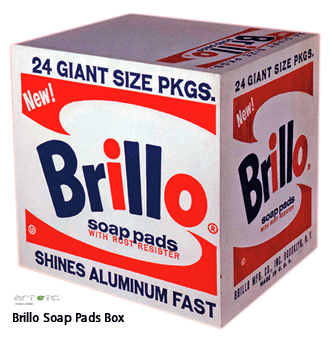 In 1964, with a series of sculptures, Warhol’s factory production methods and his subject-matter reached their logical culminating point. He made replicas of the cardboard cartons used for delivering goods to shops and supermarkets. As motifs, like the signs he used in his paintings and prints, Warhol chose the most familiar and common boxes such as Kellogg's corn flakes, Brillo soap pads etc. Incidentally, one of the boxes he selected was a Campbell’s box carting cans of tomato juice. He got carpenters to construct dozens of such cartons with plywood and, with the help of his assistants, hand-painted them with a basic colour corresponding to the exact shade of cardboard. Then he screen printed the facsimiles of the original labels in colours used in them on each side of the box. This whole process would closely imitate the actual process of marking a carton. Once finished these cartons would be taken to the gallery (the market place) to be displayed in different configurations – singly, in rows or piled up like they are kept in a large store or warehouse and the collectors would be invited to buy them in stack. In this series Warhol moved away from his usual blatant commentary on consumerism. By using the replicas of those cartons Warhol brought the audience’s attention not to the goods that were in the box but to the box itself. These carefully manufactured and immaculately finished cartons allude to the powerful yet invisible force behind the production and marketing of the products themselves. They are symbols of the complicated network of demand and supply essential to the formation of a consumerist culture.
In 1964, with a series of sculptures, Warhol’s factory production methods and his subject-matter reached their logical culminating point. He made replicas of the cardboard cartons used for delivering goods to shops and supermarkets. As motifs, like the signs he used in his paintings and prints, Warhol chose the most familiar and common boxes such as Kellogg's corn flakes, Brillo soap pads etc. Incidentally, one of the boxes he selected was a Campbell’s box carting cans of tomato juice. He got carpenters to construct dozens of such cartons with plywood and, with the help of his assistants, hand-painted them with a basic colour corresponding to the exact shade of cardboard. Then he screen printed the facsimiles of the original labels in colours used in them on each side of the box. This whole process would closely imitate the actual process of marking a carton. Once finished these cartons would be taken to the gallery (the market place) to be displayed in different configurations – singly, in rows or piled up like they are kept in a large store or warehouse and the collectors would be invited to buy them in stack. In this series Warhol moved away from his usual blatant commentary on consumerism. By using the replicas of those cartons Warhol brought the audience’s attention not to the goods that were in the box but to the box itself. These carefully manufactured and immaculately finished cartons allude to the powerful yet invisible force behind the production and marketing of the products themselves. They are symbols of the complicated network of demand and supply essential to the formation of a consumerist culture.
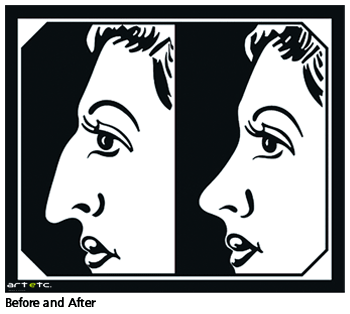 Warhol wanted money and fame. He was fascinated with stardom and Marilyn Monroe represented the ideal of beauty and womanhood to him. He was the quintessential product of the consumerist culture. In such cultures any physical deformity/ugliness/flaw is considered as a crime against the perfect society. In 1960 Warhol did a number of works with the aids of news paper advertisements such as Where is Your Rupture and Dr. Scholl in which a woman’s finger peels back to reveal a corn on her toe. In 1960, 1961 and 1962 Warhol produced three versions of the work titled Before and After. It is a two part image that shows an older woman with a deformed nose in the left half and in the right half the same woman, only much younger looking because of a perfect nose that she acquired by plastic surgery. These works may or may not be direct criticism of such processes of exclusion in terms of physical flaws for Warhol himself suffered from recurrent anxiety about his own appearance regarding his receding hairline and a deformed nose. It went to such extent that in early 1950s he began wearing wigs. In 1956/57 he even had had plastic surgery to correct the shape of his nose. These works appear to be more like public confessions of private embarrassments and anxieties than criticism.
Warhol wanted money and fame. He was fascinated with stardom and Marilyn Monroe represented the ideal of beauty and womanhood to him. He was the quintessential product of the consumerist culture. In such cultures any physical deformity/ugliness/flaw is considered as a crime against the perfect society. In 1960 Warhol did a number of works with the aids of news paper advertisements such as Where is Your Rupture and Dr. Scholl in which a woman’s finger peels back to reveal a corn on her toe. In 1960, 1961 and 1962 Warhol produced three versions of the work titled Before and After. It is a two part image that shows an older woman with a deformed nose in the left half and in the right half the same woman, only much younger looking because of a perfect nose that she acquired by plastic surgery. These works may or may not be direct criticism of such processes of exclusion in terms of physical flaws for Warhol himself suffered from recurrent anxiety about his own appearance regarding his receding hairline and a deformed nose. It went to such extent that in early 1950s he began wearing wigs. In 1956/57 he even had had plastic surgery to correct the shape of his nose. These works appear to be more like public confessions of private embarrassments and anxieties than criticism.
It is difficult to understand the position of Andy Warhol as an individual within this cultural condition. As an artist he revolutionized the definition and the whole concept of fine arts as an elite language by introducing images from a popular vocabulary, mass-producing and recycling them and using even the technical flaws of silk screen printing process and its accidental effects for his artistic purposes. As an individual, like so many people belonging to a confusing historical moment, he inherited the passions for comfortable, money oriented and materialistic life and yet the problems of such passions and their often disturbing consequences were not hidden from him. He was obsessed with art as a business and proclaimed them as philosophical tenets. According to him, “Being good in business is the most fascinating kind of art". He was like a mirror that could not serve its purpose if nobody looked into it but he was a magical mirror that impartially showed the society’s shames, secret flaws and the layered lives of people.